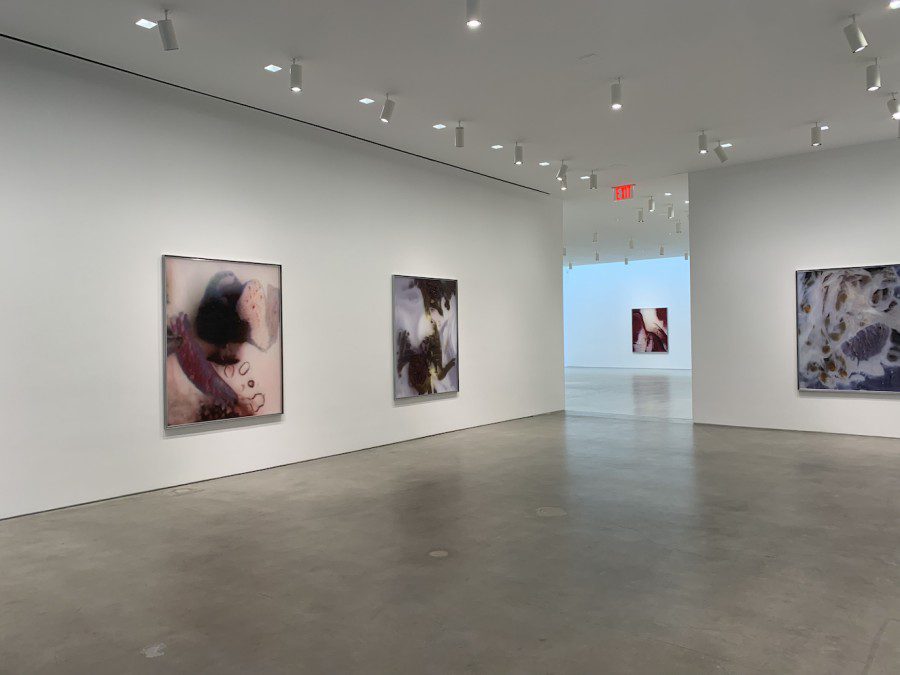Anicka Yi’s “ÄLñ§ñ” disrupts traditional forms of art making
Anicka Yi proves abstract art doesn’t have to be boring.
Anicka Yi’s “ÄLñ§ñ” exhibition at Gladstone Gallery is available from Oct. 6 to Nov. 12 at 515 West 24th Street. (Natalia Palacino Camargo for WSN)
November 8, 2022
Anicka Yi’s “ÄLñ§ñ” at Gladstone Gallery marks the artist’s first exhibition in both the gallery and in New York in almost a decade. Yi’s genius in reconstructing how we approach artmaking shines throughout the exhibit, breathing new life into her career.
Running from Oct. 6 – Nov. 12 at W. 24th St., “ÄLñ§ñ” presents Yi’s recent experimentation in painting. With 17 new large-scale paintings, the current exhibit is reminiscent of her early explorations in mark making. The large-scale canvases make use of diverse found materials as this experimentation of materiality and technique conveys scenes of intimacy in nature through an enlarged view of the microscopic world.
Through her inventive approach, Yi blurs the line between abstract and figurative painting, creating dream-like pieces through the depiction of amorphous colored shapes. Among these organic brushstrokes and natural washes of color, the viewer can recognize biological elements like “blood cells and fish eggs, scratched and ruptured skin, polyps and crustaceans, and the undulations of a deep ocean floor,” according to Gladstone Gallery’s press release.
Works such as “M†L§†K£R§§” demonstrate Yi’s ability to create depth in the visual field as well as a grounded meaning, despite the abstract nature of her practice. The light purple-gray background makes the viewer feel as though they are examining the scene from underwater, while the contrasting golden and red hues allude to amphibian creatures. With a trace of what looks like frog legs and eggs, this abstract piece manages to bring perspective to microscopic scenes that are often overlooked.
Similarly, “††L” incorporates contrasting neutral colors and bright-colored shapes to bring the main element of the painting to the foreground. The bright pink and red shapes protrude from an earth-tone background and stand out as cells within bodily fluids. The addition of aluminum frames and foggy, translucent covers over the paintings contribute to a feeling of sterility and microscopic inspection.
Yi’s work is often informed by scientific research and explores the intersection of macrobiotics, humans and politics. As seen in this exhibition, Yi often experiments with incompatible materials, questioning the differences between living organisms and machines. Examining such intimate work in such a large gallery space brings to mind questions of biopolitics and our approaches to exploring the natural world.
Within her work, Yi has not been a stranger to the interdisciplinary practice between biology and art. Known for her use of unorthodox materials, Yi has worked with yeast, bacteria and even taxidermied animals.
In a 2017 article with the New York Times, Yi expressed the parallels between the work of scientists and artists. “We work very similarly,” said Yi. “It’s just that we work almost in reverse timelines: Scientists have their hypothesis and then spend the next 20 or 30 years of their career trying to prove it, whereas artists won’t really understand what their hypothesis was until the end of their career.” Due to her practice’s relationship with biological entities, Yi is unsure where her work will take her as it continues to evolve and mutate organically.
Despite starting her practice just 15 years ago, she has established herself as one of the biggest and most innovative artists of our time. She exhibited at the Guggenheim as the 2016 Hugo Boss Prize winner, the 2017 Whitney Biennial and the Venice Biennale. Presenting her works “Biologizing the Machine (terra incognita)” and “Biologizing the Machine (tentacular trouble)” in the 2019 58th edition of the Venice Biennale, Yi explored ways of communication between artificial intelligence and organisms.
Going beyond the biological, Yi has also critiqued institutional sexism and power dynamics. In her new exhibition, Yi continues her exploration of materials that have often been ignored by the canonical white male-dominated art world. Her choice to involve viewers’ sense of smell goes against the visual-centric nature of the art world, dismantling the historical conditioning of art consumption. Works that display images of bacteria and organic cultures do so in an open way, inviting the viewer to touch them.
The study of biological forms through her work in the vast sterile gallery space mimics the space of a lab. The paintings stand as giant microscopic samples that give us an insight into the unseen natural world. Yi’s approach to making art through the lens of research and deep theoretical knowledge expands our understanding of painting practices. Blending the barrier between the sculptural and painterly realms, Yi’s artistic agency continues to question previous notions of the artist’s relationship to the work. With “ÄLñ§ñ,” Yi steps further and questions the relationship between viewers and how they’ve been trained to engage with art.
Contact Natalia Palacino at [email protected].
























































































































































